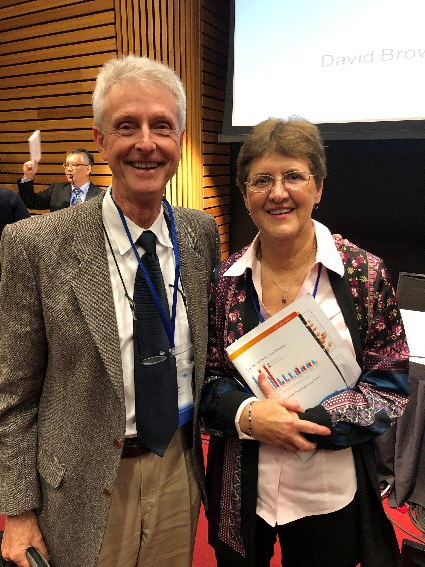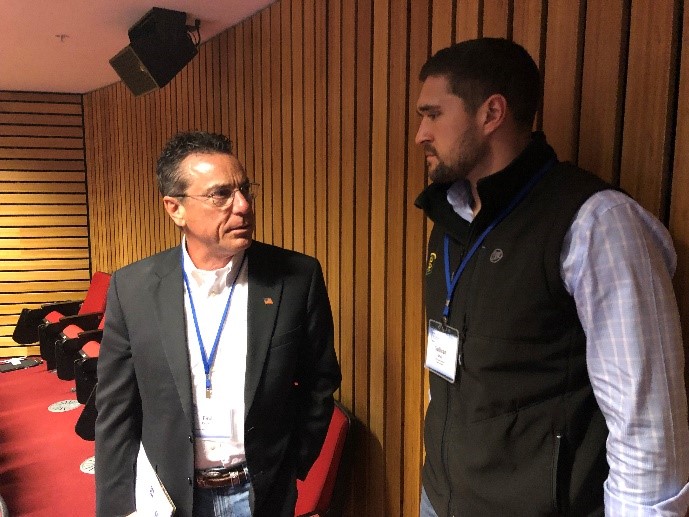The term “Valley of Death” can describe the gap between a promising new technology and an economically feasible or commercially viable product. Closing this gap was an important focus of the California Bioresources Economy Summit, held Jan. 29–30 in Berkeley, California.
Calling the circular bioresources economy “California’s next gold rush,” keynote speaker Mary Maxon of the Lawrence Berkeley Laboratory launched the summit by highlighting the potential to produce biofuels, bio-based chemicals and other bioproducts from sustainable biomass while reducing carbon emissions and creating jobs.
 Stephen Kaffka, director of the California Biomass Collaborative at UC Davis, moderated Session 4: Learning from Biomass Supply Chains, which featured ABC Chief Scientific Officer Karen Lapsley, PhD.
Stephen Kaffka, director of the California Biomass Collaborative at UC Davis, moderated Session 4: Learning from Biomass Supply Chains, which featured ABC Chief Scientific Officer Karen Lapsley, PhD.
Karen Lapsley, PhD, chief scientific officer at the Almond Board of California (ABC), participated in a panel, “Learning from the Biomass Supply Chains,” representing one of the major biomass supply chains — agriculture.
“The Almond Board was the only organization representing California farmers in this important discussion of how we can turn our growing supply of biomass from forest, agriculture and urban sectors into solutions to help meet our state’s climate and air quality goals,” Lapsley said. “Our presence was conspicuous. We stood out, in a good way.”
In her presentation, Lapsley shared the story of the almond community’s journey toward achieving zero waste from the orchard while putting everything we grow to optimal use. Lapsley pointed out almond kernels only make up about 30% of what we grow in the orchard, with hulls and shells making up about 50% and 20%, respectively.
“In terms of zero waste of everything we grow, we’re already there,” Lapsley told the gathering, noting that hulls and shells often end up as livestock feed and bedding rather than going to a landfill. “We are now seeking higher value uses, either economically or environmentally.”
Lapsley also discussed options for finding the highest and best uses of woody biomass at the end of an orchard’s productive life.
“That biomass does not have to leave the orchard,” Lapsley said. “Whole Orchard Recycling is an option that could have benefits for soil health and carbon sequestration. The carbon market is one way we could incentivize farmers to adopt this new practice.”
Lapsley also highlighted Almond Board-funded research in new uses for hulls and shells, from novel food and feed products to incorporation in recycled plastics.
Stephen Kaffka, director of the California Biomass Collaborative at UC Davis, moderated the biomass supply chain panel, which included Jeff Welch from Aemetis, the company building a new biofuel plant in Riverbank, California, which plans to turn old trees from almond and walnut orchards into cellulosic ethanol for transportation fuel. Other panelists included representatives from CR&R, a southern California waste management company, and the California Forestry Association.
 ABC Biomass Workgroup members Paul Pereira and Sullivan Grosz discuss opportunities for almond growers in a bioresources economy.
ABC Biomass Workgroup members Paul Pereira and Sullivan Grosz discuss opportunities for almond growers in a bioresources economy.
“This panel was one of the most informative held during the meeting and stimulated a lot of discussion. It helped to have examples of the amounts of biomass materials available in the state and the opportunities and constraints on using them,” Kaffka said. “The almond industry is a leader in anticipating what a bioeconomy and low-carbon agricultural industry must look like. Dr. Lapsley’s presentation and overall participation was a very valuable element in the success of the Bioeconomy meeting.”
The Almond Board co-sponsored the two-day event, providing an opportunity to showcase the Almond Orchard 2025 Goals to an important audience of government, academia and industry players engaged in propelling the state’s bioeconomy to the next level. In addition to Lapsley’s panel participation, the event was attended by ABC board member Kent Stenderup, Biomass Workgroup chair and board member Caleb Gervase, Biomass Workgroup members Paul Pereira and Sullivan Grosz, and ABC Senior Director of Global Communications Daren Williams.
The Lawrence Berkeley National Laboratory, University of California at Berkeley and California Air Resources Board hosted the Summit.